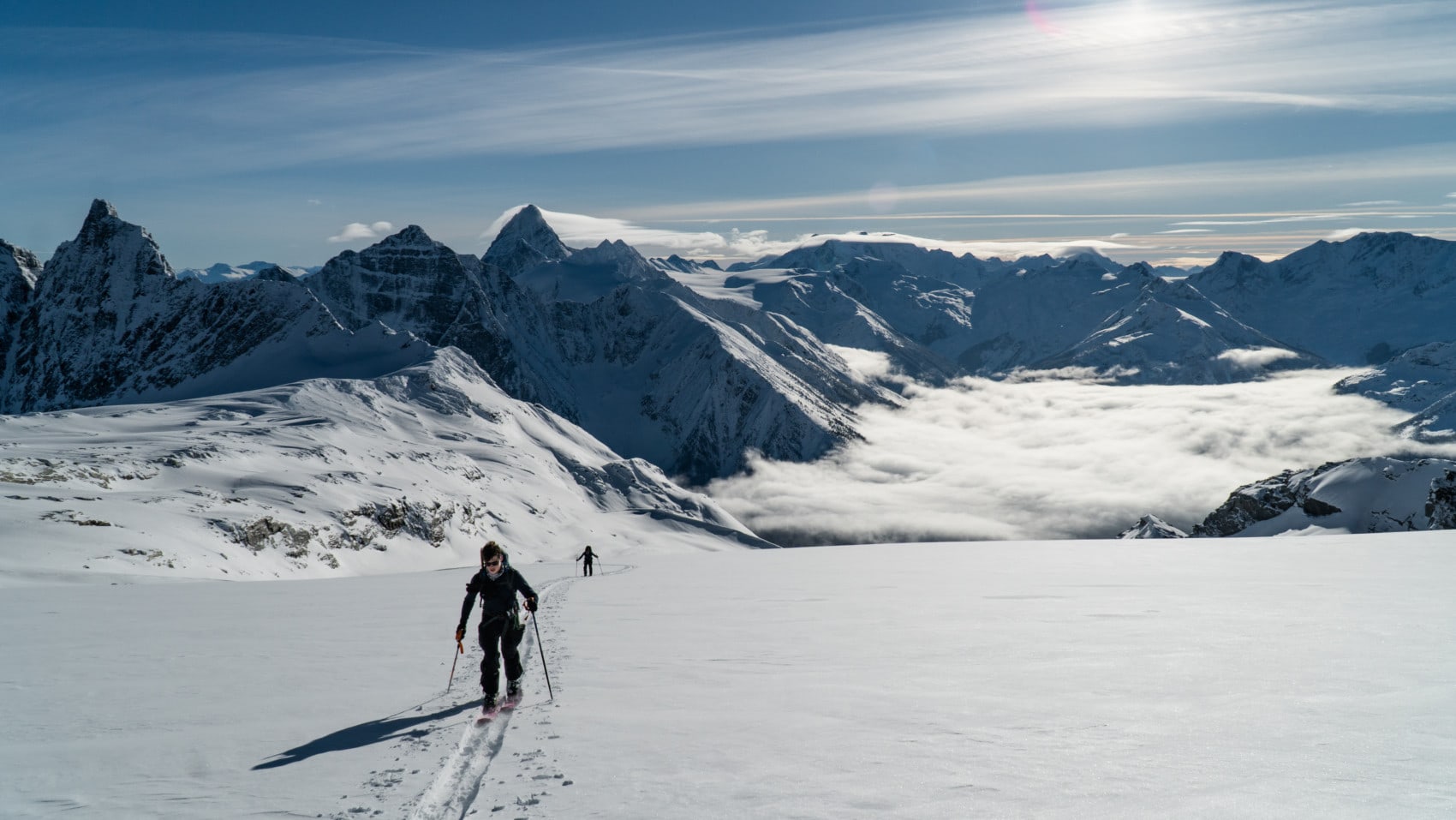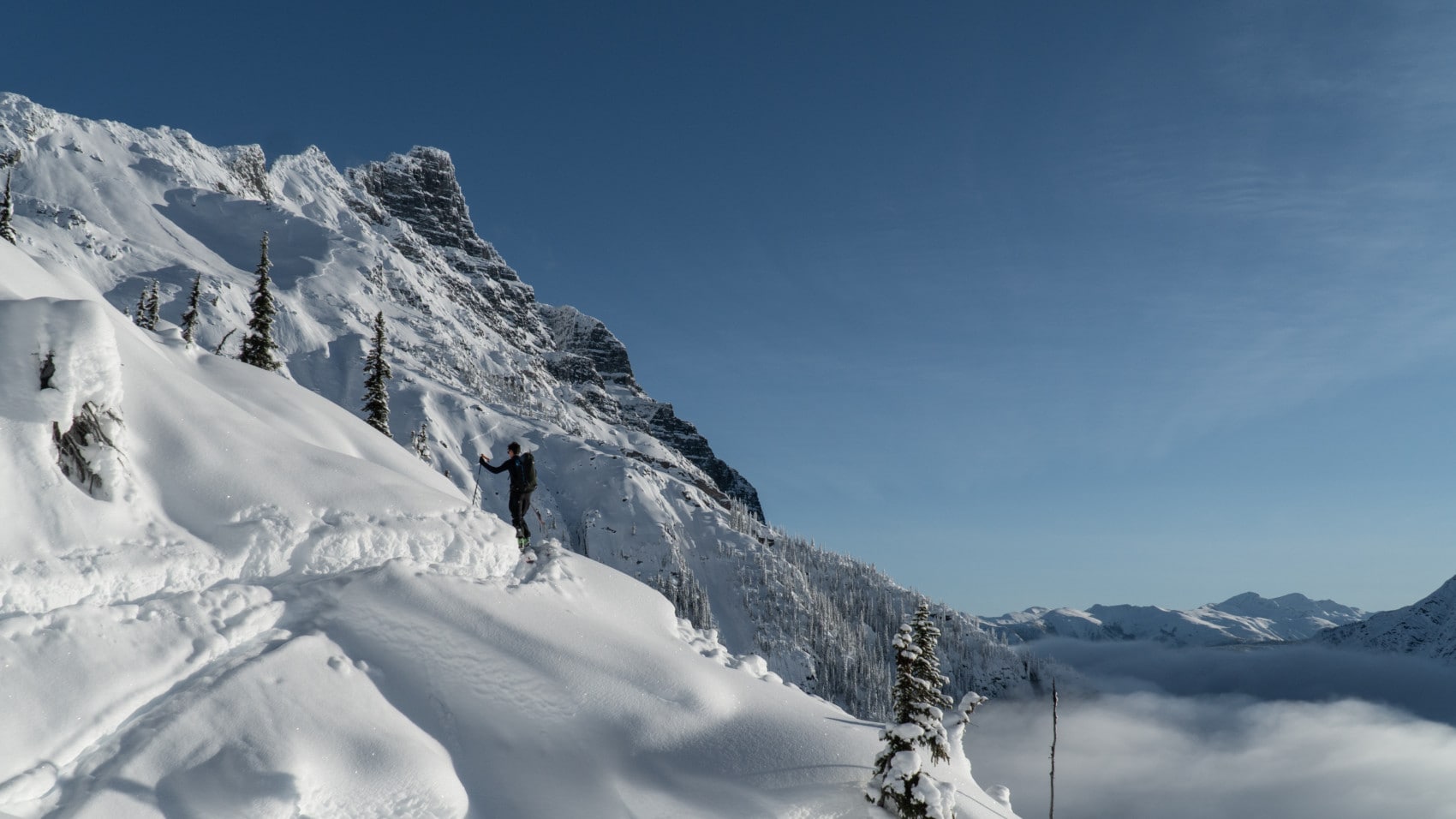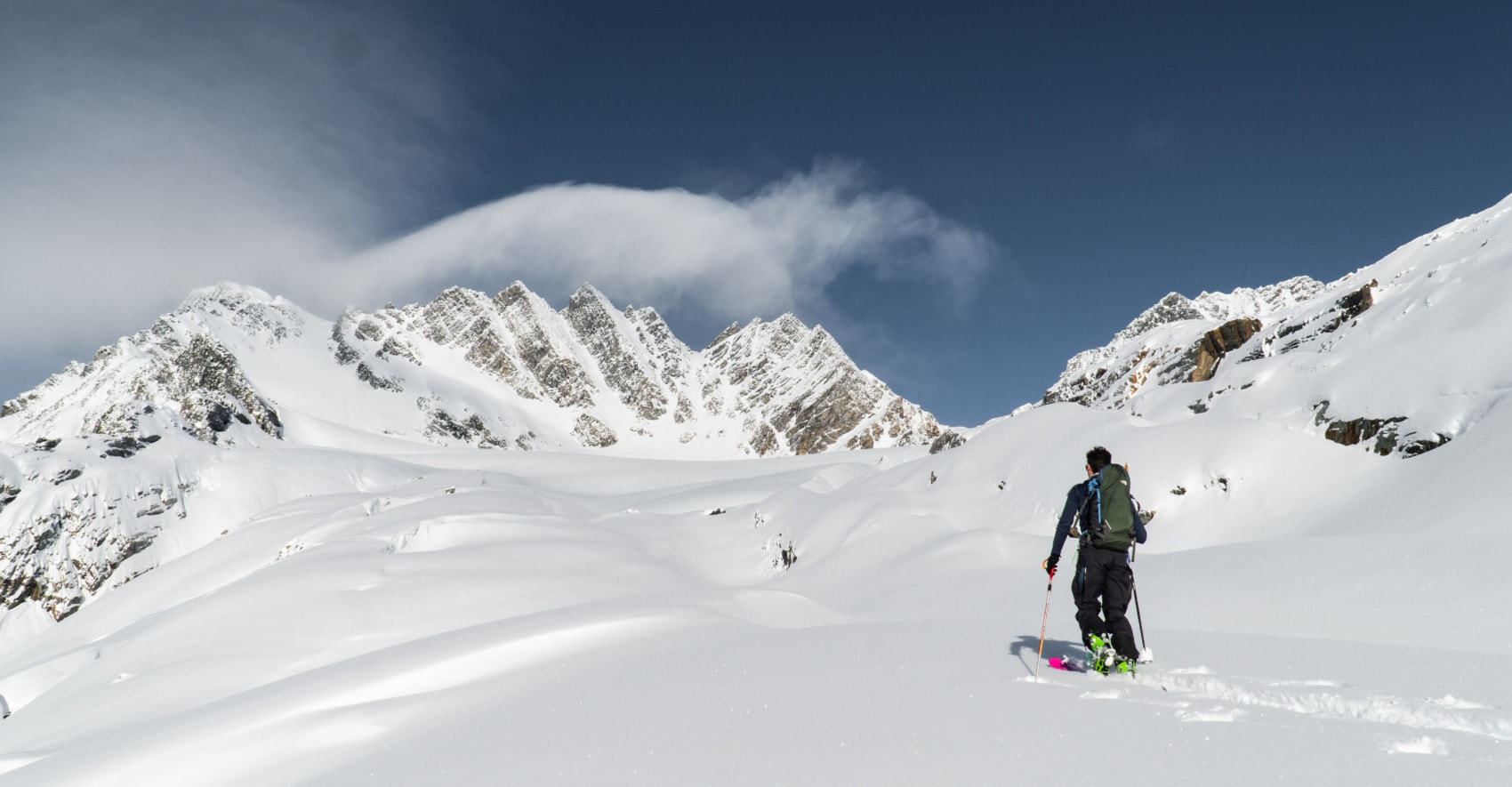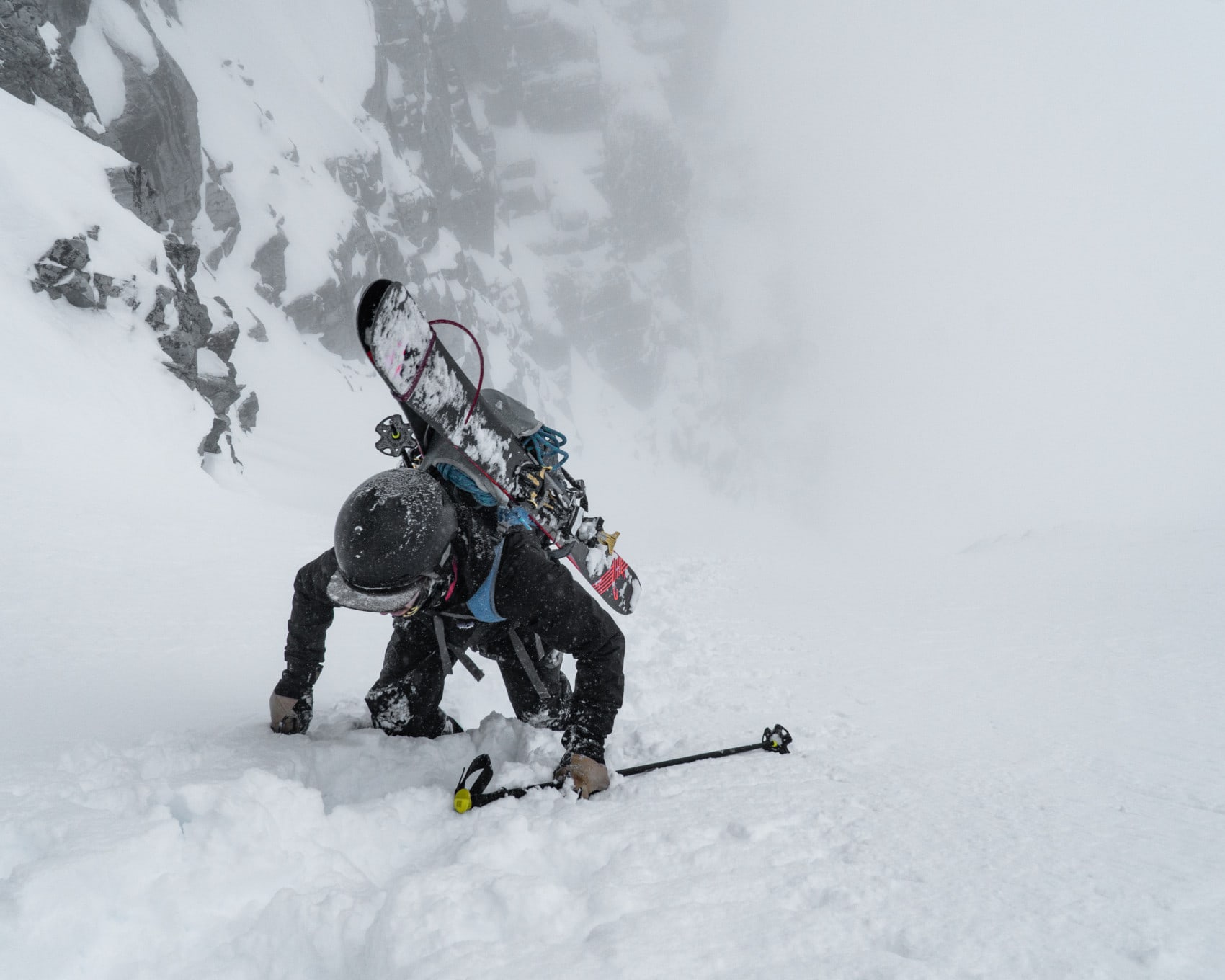Swiss Couloir, located in Rogers Pass, is a line I’ve been aching to check off my bucket list for close to a year now, ever since I first toured up the Rogers area in Rogers Pass, BC. I offered to take Cedrik up with me. He didn’t have to be asked twice. After emerging from the valley clouds, we were greeted with a perfect bluebird day. A 250-meter bootback through deep snow got us the entrance of Swiss Couloir. This athletic feat was followed by a 2000-meter descent through wind crust, glacial powder, and avalanche debris.
This route is located within a Winter Restricted Area (WRA) governed by the Winter Permit System. Please check the WRA status before travelling through it.
Related: Ross Peak Southeast Couloir: Steeps and Bare Ice

Report from December 28, 2019
Our day began with a morning start at 7 AM, as soon as Parks Canada allowed access to the area through the Winter Permit System. We checked our bags, slapped our skins and headed up the Hermit Trail. The light dusting of fresh snow made progress slow. Our skins slid on the dust-on-crust, providing barely enough traction to climb the steep switchbacks. As the trees were spacing out, we poked out of the thick valley clouds and were greeted by blue skies and cold sunlight.
Winter Restricted Area Link
Luckily, a track had already been set. Through obvious trial and error, the uptrack led us through a series of winding drainages, carved into solid rock by glacial runoffs over millions of years. Phew! Breaking a trail through the deep snow would have been frustrating. Add that to the 2000 vertical meters of ascent and it would have been an impressive feat of endurance.

We stopped for a minute or two, letting our pale white faces bask in the sunlight. After not seeing it for more than two weeks, we were ecstatic. With a bit of vitamin D and my usual ginger-lemon-green tea, our aching bodies now were revitalized.
Electrolyte Drink Advice
After 2 hours, we arrived at the Lizard Moraine, a large lateral moraine towering over the valley leading up to the Swiss Glacier. We veered off the established uptrack every now and then: it was either too steep or traversing the rolling terrain inefficiently. 2000-meter ascents call for efficiency. The last guy must have had crazy glue under his skins to climb those 20-degree inclines. We took it to ourselves to set a new track, this time optimizing the climb.

We eventually gained the toe of the Swiss Glacier. Our objective, Swiss Couloir, finally came into view with the rest of Rogers Pass behind us. From left to right, it consists of Rogers, Grant, Flemming, Swiss and Truda Peaks. Those summits stand at an elevation of more than 3100 meters and are divided by steep, narrow skiable couloirs, running from top to bottom.

The Swiss Couloir was up there, a thin scar in Swiss Peak’s south-facing headwall. What a classic line! A 250-meter long ski descent down a 50-degree chute, roughly 6-meters wide at its choke. This is just what I was looking for to test my ski-mountaineering skills. A quick glance at the line made one thing obvious: the bootpack up the chute would be strenuous… to say the least.

We traversed the glacier unroped. At this time of the year, the crevasses or bergshrund were completely filled in, making crossing the wind-scoured glacier an easy task. I still carried the rope and climbing rack in my pack, just in case.
During the long glacier traverse, I thought of how I felt during last year’s winter ascent of Rogers Peak. I remembered being at very limit of my athletic capabilities. I remembered the elevation altering my body’s chemical balance. I felt drowsy and exhausted as I was entering the early stage of altitude sickness. Now, I was in tip-top shape. No doubt, a summer of mountaineering in the high-alpine and more than 20 days of ski touring this winter helped out tremendously. My good fitness didn’t stop a fellow skier from smoking us on the ascent up the glacier with his fancy carbon skis and ultralight ski boots.

Typical of Rogers Pass, we arrived at the base of the Swiss Couloir after several hours of uphill sweating. Once we found a safe spot, we dug a snow profile, representative of the conditions in the couloir, at a depth of 1.60m. We were looking for weak interfaces between various layers of snow. Our shovel compression test results: a 20cm thick wind slab would release with a little effort. This was not too big of a problem. Wind slabs are generally found in specific isolated areas, in this case, the climber’s left of the couloir.

Satisfied by our tests, we climbed right of the couloir, preferring exposing ourselves to a few pebbles falling down the headwall then ascending the sketchy winds slabs on the left. It was too far to spot, but we kept in mind the likelihood of a cornice breaking above us, at the entrance of the chute. Luckily, it turns out there wasn’t a cornice to worry about.
As the heavy fog rolled in within seconds of us starting the long 250-meter bootpack, we were joined by fellow mountaineers Seth and Jessie, who gladly helped us set the track.
Couloir Skiing Advice
The snow was deep, progress was slow. Midway up the chute, the winds picked up, prickling our faces with icy crystals. This was going to be what mountaineers call an “epic”.

We alternated leading the way until 20 meters from the top. At this point, Cedrik had encountered questionable snow in the chutes choke. I raced up to him and inspected the conditions with the adze of my ice axe. A thick wind slab lied over a layer of sugary facets, rectangular snow crystals that form a dangerous sliding interface. If the mountains thought me one thing, it’s to curb your ambitions when in doubt. There’s no point in sacrificing safety for a win. It was time to turn back… 20 meters from the entrance. After all, the couloir will still be there for a long long time.

We hid behind a boulder and transitioned for the descent. Bootpacks are a great opportunity to feel the snow on the way up. Ski conditions were as expected. Slightly crusty on top with some half-decent powder below. This made for a tough descent. That’s the thing about ski-mountaineering. The very locale in which we practice our sport, the alpine, increases the chance of skiing awful snow. On top of that, the Rogers area is known for its high winds and solar crusts.
We parted ways with our newfound friends and headed off the Swiss Glacier, over an oblong lateral moraine, and into the Lizard Moraine. Since the glacier kept the surface cooler, the snow was light, fluffy and powdery. Cedrik and I carved several heli-ski turns down the mellow face.

After skiing down the Hermit avalanche path, we arrived at the car by 3:15 PM. We were both stoked to have finally checked Swiss Couloir, a Rogers Pass classic.
If you’re looking to ski lines like we do, check out my master article, How To Get Into Ski Touring. There’s a section on ski-mountaineering.
Photos
Mt Macdonald under the rising sun. Photo: Beyond Our Peak Cedrik climbing an alternate path up the Hermit Trail, Mt Tupper in the back. Photo: Beyond Our Peak Convoluted terrain above the clouds. Photo: Beyond Our Peak Cedrik and the Asulkan Valley. What a view! Photo: Beyond Our Peak Cedrik slashing a cautionary turn down Swiss Couloir. Photo: Beyond Our Peak Cedrik scrutinizing the slope above. Photo: Beyond Our Peak
Statistics
| Peak Elevation | 3145m |
| Vertical Gain/Loss | 1860m |
| Distance Traveled | 12.1km |
| Duration | 8h |
For more beta on my adventures, check out the Route Map. This google maps interface is a repository of some of my ski touring, mountaineering and hiking adventures. It includes a loose GPS trace for your convenience.




